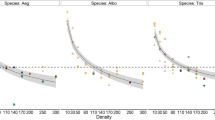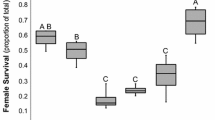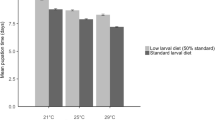Abstract
The eastern treehole mosquito, Aedes triseriatus (Say), was used in two experiments testing assumptions and predictions of life history theory. Experiment 1 employed direct, phenotypic manipulations of reproductive investment (blood meal mass) to test for a physiological cost of reproduction expressed as reduced longevity with increasing reproductive investment. As predicted, A. triseriatus from Vero Beach, Fla., showed costs increasing with investment in reproduction, but mosquitoes from Ashland, Va., showed the opposite response. This difference in apparent costs of reproduction may influence patterns of reproductive investment documented in the second experiment. To test the hypothesis that different predator-induced expected mortality rates among juveniles result in different patterns of reproductive allocation, we compared the allocation tactics of A. triseriatus from eight geographic populations, four sympatric with and four allopatric to the predatory mosquito, Toxorhynchites rutilus (Coq). Path analysis identified a phenotypic trade-off between offspring size and number, supporting this fundamental assumption of life history theory. Analysis of covariance revealed significant variation among populations in replete blood meal mass, reproductive output per unit blood meal mass (both measures of reproductive investment), mean egg mass, and egg number, although intrapopulation variation greatly exceeded interpopulation variation for all traits. Despite this variation among populations, there were no consistent or significant differences between populations sympatric vs. allopatric to the predator T. rutilus. This experiment therefore fails to support the hypothesis that greater mortality of juveniles should be associated with greater offspring size, lower offspring number, and lower reproductive investment. Our results are interesting, however, because they suggest that reproductive investment, reproductive output, and the trade-off between offspring size and number may evolve independently in this system.
Similar content being viewed by others
Author information
Authors and Affiliations
Additional information
Received: 12 May 1998 / Accepted: 8 February 1999
Rights and permissions
About this article
Cite this article
Frankino, W., Juliano, S. Costs of reproduction and geographic variation in the reproductive tactics of the mosquito Aedes triseriatus . Oecologia 120, 59–68 (1999). https://doi.org/10.1007/s004420050833
Issue Date:
DOI: https://doi.org/10.1007/s004420050833




